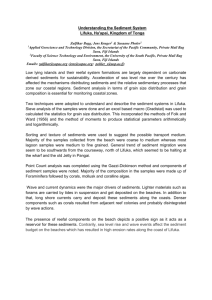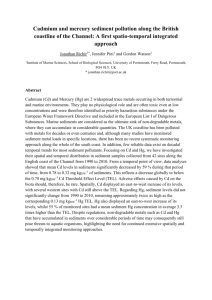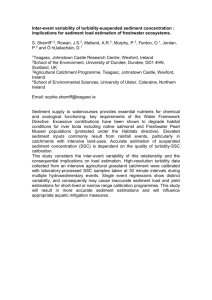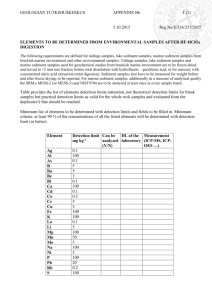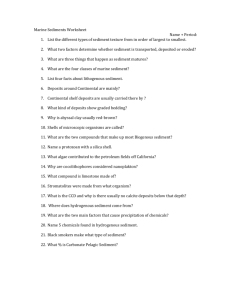Zhang_GBEP_Full_Paper
advertisement
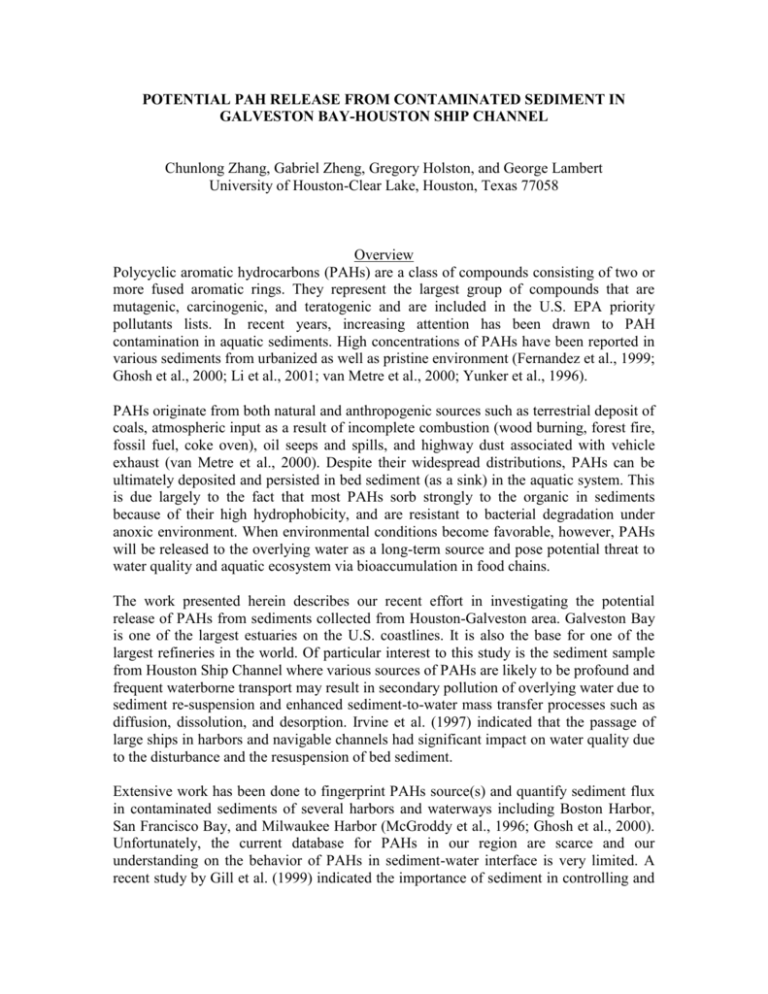
POTENTIAL PAH RELEASE FROM CONTAMINATED SEDIMENT IN GALVESTON BAY-HOUSTON SHIP CHANNEL Chunlong Zhang, Gabriel Zheng, Gregory Holston, and George Lambert University of Houston-Clear Lake, Houston, Texas 77058 Overview Polycyclic aromatic hydrocarbons (PAHs) are a class of compounds consisting of two or more fused aromatic rings. They represent the largest group of compounds that are mutagenic, carcinogenic, and teratogenic and are included in the U.S. EPA priority pollutants lists. In recent years, increasing attention has been drawn to PAH contamination in aquatic sediments. High concentrations of PAHs have been reported in various sediments from urbanized as well as pristine environment (Fernandez et al., 1999; Ghosh et al., 2000; Li et al., 2001; van Metre et al., 2000; Yunker et al., 1996). PAHs originate from both natural and anthropogenic sources such as terrestrial deposit of coals, atmospheric input as a result of incomplete combustion (wood burning, forest fire, fossil fuel, coke oven), oil seeps and spills, and highway dust associated with vehicle exhaust (van Metre et al., 2000). Despite their widespread distributions, PAHs can be ultimately deposited and persisted in bed sediment (as a sink) in the aquatic system. This is due largely to the fact that most PAHs sorb strongly to the organic in sediments because of their high hydrophobicity, and are resistant to bacterial degradation under anoxic environment. When environmental conditions become favorable, however, PAHs will be released to the overlying water as a long-term source and pose potential threat to water quality and aquatic ecosystem via bioaccumulation in food chains. The work presented herein describes our recent effort in investigating the potential release of PAHs from sediments collected from Houston-Galveston area. Galveston Bay is one of the largest estuaries on the U.S. coastlines. It is also the base for one of the largest refineries in the world. Of particular interest to this study is the sediment sample from Houston Ship Channel where various sources of PAHs are likely to be profound and frequent waterborne transport may result in secondary pollution of overlying water due to sediment re-suspension and enhanced sediment-to-water mass transfer processes such as diffusion, dissolution, and desorption. Irvine et al. (1997) indicated that the passage of large ships in harbors and navigable channels had significant impact on water quality due to the disturbance and the resuspension of bed sediment. Extensive work has been done to fingerprint PAHs source(s) and quantify sediment flux in contaminated sediments of several harbors and waterways including Boston Harbor, San Francisco Bay, and Milwaukee Harbor (McGroddy et al., 1996; Ghosh et al., 2000). Unfortunately, the current database for PAHs in our region are scarce and our understanding on the behavior of PAHs in sediment-water interface is very limited. A recent study by Gill et al. (1999) indicated the importance of sediment in controlling and mediating the concentration of several trace elements and nutrients in Galveston Bay. To date no such information is available on the behavior of PAHs in aforementioned water systems. This work was initiated in order to gain a better understanding of the mass transfer of PAHs at the sediment-water interface. In particular, the emphases of this work are to: (1) develop a thermodynamic equilibrium model that describes the extent of PAH exchange between sediment and the overlying water, (2) quantify the kinetic rate of PAH sorption at the water-sediment interfaces and estimate the aqueous flux rate of PAH, (3) elucidate the key factors in contributing elevated PAH concentrations in the aqueous phase. Methods Chemicals including naphthalene, phenanthrene and pyrene were selected as the probe PAHs, as they represent a wide range of aqueous solubilities (naphthalene: 31.7 ppm; phenanthrene, 1.29 ppm; pyrene: 0.135 ppm). These PAHs compounds and their calibration standards were purchased from Aldrich Chemical Co. and Suppelco. Six sediments were collected in Houston-Galveston area (Table 1). Samples were air-dried and sieved for batch sorption studies, and subsamples were also stored at –70oC for PAH characterization. Table 1. Test Sediment and Sampling Location Location Horsepen Bayou near UHCL (HPB) Clear Lake near Hilton Hotel (CLK) Galveston Bay near Kemah Post 4-6 (BAY) Houston Ship Channel, Barge Holding Area (HSC1) Houston Ship Channel, Lynchberg Ferry (HSC2) Houston Ship Channel, New Fed Hartman Bridge (HSC3) GPS Reading 29o34.789N/95o05.542W 29o19.256N/94o55.229W 29o33.096N/95o02.181W 29o47.251N/95o03.932W 29o45.840 N/95o04.833W 29o42.253 N/95o01.059W Water Depth (feet) 4 6 8 27 50 51 Three PAHs spiked in air-dried sediment samples for sorption study were extracted with EPA SW 846 method 3550B – three successive ultrasonic extractions (1 g sediment in 5 mL 50:50 mixture of hexane and acetone, 15 s on and 15 s off pulsing for a total of 3 min). Aqueous PAHs were extracted using 3 mL methylene chloride in 10 mL sample. Wet samples for sediment characterization were extracted using a more rigorous Soxhlet extraction (3540C) without the use of a clean-up procedure (EPA method 3630C) to characterize other potential contaminants. Extracts were analyzed on 5890 GC coupled with 6972 MS detector with a 30 m x 0.32 mm x 1 µm HP-5 capillary column. The oven was held at 35°C for 10 minutes and ramped to 280°C at 12°/min. The MSD was run in Scan mode for sediment characterization and SIM mode for PAH quantification (128, 178 and 202 as the quantifier ions for naphthalene, phenanthrene and pyrene, respectively). Batch sorption studies for the acquisition of distribution coefficient (Kd) of each individual PAH were performed according to procedures described previously by Chiou et al. (1998) and Johnson et al. (2001). Into a series of 50-ml Teflon centrifuge tubes containing 1 – 2 g sediment, 20 mL DI water and various volumes (~100 L) of PAH stock solution in methanol were introduced to the sediment slurry. The sediment to water ratio were adjusted to allow significant adsorption of the test compound as well as to provide sufficient aqueous solution for quantitative measurement. Test concentrations of PAHs were determined based on the aqueous solubility. The sediment slurry was continuously mixed on a shaker at room temperature (22oC) for 48-72 h, and the solid and aqueous phases were separated by centrifugation. Aqueous phase PAH concentrations were analyzed after extraction into dichlormethane (Jee et al., 1998) and corrected with % recovery with known standards. Sorbed phase concentrations were determined by the difference of the total mass and the mass in solution. Batch desorption study were conducted in 50-mL Teflon centrifugal tubes with screw cap to minimize PAH volatilization. The same sediment/water ratio used in the previous sorption studies were followed, but with the addition of HgCl2 (100 mg/L) to prevent any bacterial degradation. Results 1. Sediment PAH adsorption isotherms Three of the six sediment samples have been tested for their adsorption isotherms of each PAH compound. The isotherms for naphthalene, phenanthrene and pyrene are shown in Figures 1, 2 and 3, respectively. Data were fitted to Freundlich and Langmuir isotherm models. Sediment adsorption isotherms were found to be linear in the range of concentration tested. 200 Cs(mg/kg) 150 100 50 0 Galveston Bay Clear Lake Horsepen Bayou 0 5 10 15 20 25 Caq(mg/L) Figure 1. Adsorption isotherm of naphthalene in various sediments 250 Cs(mg/kg) 200 150 100 50 0 Galveston Bay Clear Lake Horsepen Bayou 0.00 0.25 0.50 0.75 1.00 Caq(mg/L) Figure 2. Adsorption isotherm of phenanthrene in various sediments 8 350 7 300 Cs(mg/kg) 6 250 5 200 4 150 3 100 2 50 1 Galveston Bay Clear Lake Hosepen Bayou 0 0.00 0.03 0.06 0.09 Caq(mg/L) 0.12 0.0 0.5 1.0 1.5 2.0 2.5 0 3.0 Caq(mg/L) Figure 3. Adsorption isotherm of pyrene in various sediments The sediment-water partitioning coefficients Kd (L/kg) were determined according to the formula: Kd = CS / Caq, where CS and Caq are sediment phase concentration (mg/kg) and aqueous phase concentration (mg/L), respectively. A summary of Kd values is given in Table 2. For instance, Kd values of phenanthrene for Clear Lake, Galveston Bay, and Horsepen Bayou were 698, 298, and 52 L/kg respectively. The Kd value attributes to the organic contents of the sediment samples. The Horsepen Bayou is a clayed sediment with low organic content, while two others are silt with Clear Lake sediment being the most heavily contaminated. Table 2. Summary of sediment-water distribution coefficient (Kd in L/kg) Horsepen Bayou Galveston Bay Clear Lake Naphthalene Kd = 4.85 Kd = 2.30 Kd = 6.41 2 2 (R = 0.975) (R = 0.992) (R2 = 0.963) Phenanthrene Kd = 52.0 Kd = 298 Kd = 698 2 2 (R = 0.880) (R = 0.983) (R2 = 0.983) Kd = 52.7 Kd = 140 Kd = 477 Pyrene (R2 = 0.965) (R2 = 0.967) (R2 = 0.956) Assuming an average sediment organic carbon (SOM) of 5% (foc = 0.05), the log Koc values calculated from SOM-normalized Kd compare favorably (with an exception of pyrene) to those determined by Chio et al. (1998) who reported log Koc values are 2.613.07, 4.10-4.64, and 4.96-5.45 for naphthalene, phenanthrene and pyrene, respectively. Analytical error may have occurred due to the very low concentration of pyrene tested in the sorption study. The experimentally determined Kd value can be used to estimate the equilibrium concentration of PAHs in sediment pore water using historical data available for sediment PAHs. Our linear model is consistent with that reported by Chio et al. (1998), however, it may have limited utility as others suggested nonlinear Freundlish isotherm (Johnson and Weber, 2001). Note also that the slowly desorbing fraction of PAHs results in lower Caq, and the Kd thus obtained in short-duration study (hrs – days) will be higher than the actual equilibrium Kd. Therefore, use of such Kd will probably underestimate aqueous phase concentration (Caq) as well as PAH flux. 2. Factors affecting PAH sorption The adsorption / desorption kinetics have been tested in a batch study over a 3-week period and major factors that have potential effect on PAH partitioning have been investigated. Several important factors that may contribute to elevated PAH concentrations in the aqueous phase were tested at various simulated conditions: synthetic seawater, actual water at the same location, and DI water at pH 3, pH 5, pH 7 (static vs. mixing), and pH 9. Preliminary results have shown that mixing significantly enhanced the mass transfer and therefore the sorption rate, especially for a low organic Horsepen Bayou sediment (Figure 4). The effects of pH and composition of overlying water were minimal presumably due to the nonionic / hydrophobic adsorption of PAH compounds. Under most conditions, the PAHs appeared to irreversibly bind to sediment in a 3-week period and remained not detectable. PAH desorption was noted at low pHs and for a treatment with seawater (data not shown). 16 Clear Lake / Static Galveston Bay / Static Horsepen Bayou / Static Clear Lake / Mixing Galeveston Bay / Mixing Horsepen Bayou / Mixing 14 Naphthalene (mg/L) 12 10 8 6 4 2 0 0 5 10 15 20 25 Time (Days) Figure 4. Sorption / desorption of naphthalene in various sediments: Static vs. mixing conditions (Sediments were spiked with 15 ppm naphthalene) 3. Sediment PAH desorption rate Desorption of PAHs from soil/sediment is often biphasic – a rapid desorption from hours to days followed by a slow process from months to even years. The slowly desorbing fraction is related to intraorganic matter diffusion and hindered pore diffusion (Johnson et al., 2001), and can be expressed in the following three-parameter model: q (t ) k t s e ks t (1 s ) e r qo where q(t) – the sediment phase PAH concentration at a given time, qo – initial sedimentphase PAH concentration, s – slowly desorbing fraction, 1-s – rapidly desorbing fraction, ks and kr – apparent first-order rate constants for the slowly and rapidly desorbing fractions, respectively. Table 3 lists the typical values of three parameters in the above kinetic model. The time required to reach pseudo desorption equilibrium predicted by this model varies from 2 weeks (Cornelissen et al., 1998) to about 8 months. Figure 5 is a simulated desorption profile based on the typical values chosen from Table 3, i.e., s = 0.7, ks = 1.5x10-3 day-1, and kr = 0.2 day-1. The difference in the kinetic rates between slowly desorbing and rapidly desorbing PAHs is evident. Figure 5 also implies that experiment duration commonly used in desorption studies (days to weeks) are inappropriate for PAHs when slowly desorbing fraction may be significant. Table 3. PAH desorption rate parameters for the three-parameter biphasic first-order desorption model Source: ks (day-1) kr (day-1) s Ghosh et al. (2001)* 0.06 5.01x10-3 0.80 ¶ 4 Cornelissen et al. (1998) 0.2-0.74 1.92-4.56x10 19.2-67.2 Johnson and Weber (2001)§ 0.69-0.736 1.38-3.01x10-3 0.134-0.362 Johnson et al. (2001)§ 0.657-0.736 1.38-2.63x10-3 0.134-0.332 ¶ § *Clay/silt (<63 µm); 2-4 ring PAHs; Phenanthrene in a sediment containing 8.27% sediment organic matter. PAH fraction remained: q(t)/q 0 Sum of slowly and rapidly desorbing PAHs (B) 1.0 1.0 0.9 0.9 0.8 0.8 0.7 0.7 0.6 0.6 0.5 0.5 0.4 0.4 0.3 0.3 0.2 0.2 0.1 0.1 0.0 0.0 0 100 200 300 Time (days) 400 500 0 100 200 300 400 PAH fraction remained: q(t)/q 0 Slowly desorbing PAHs Rapidly desorbing PAHs (A) 500 Time (days) Figure 5. Simulated PAHs desorption profile from a contaminated sediment 4. Sediment PAH flux rate Contaminant flux from sediment is important especially in shallow water in Texas estuaries including bay waters (e.g., 6-12 feet in Galveston Bay). We have not been able to give rigid estimate of PAH flux from contaminated sediment, our effort herein is to provide an order of magnitude estimate on the flux rate based on the literature values listed in Table 4. If the flux rate in Lake Michigan is assumed, the mass flux rate of PAHs in Ship Channel (length: 51 miles; width: 400 ft) can be estimated in the range of 0.9 ~ 10.5 kg/yr. This is equivalent to the contribution of an elevated concentration in the range of 6.5 ~ 76.6 ppt in the overlying water assuming the average depth of 45 ft and a hydraulic retention time of one year. Note that the actual PAH concentration in the sediment pore water adjacent to sediment bed may be significantly higher than the estimated concentration due to the limitation of mass transfer to the overlying water. Elevated PAH concentrations in sediment porewater could pose additional stress to benthic organisms in the Ship Channel and bay area. Similarly, the total PAH flux in Galveston Bay can be estimated to be in the range of 140 ~ 1,630 kg/yr based on a surface area of 600 square miles. This is comparable to 371 kg/yr of PAHs contribution from the lower watershed nonpoint sources (The Galveston Bay National Estuary Program, 1994). Table 4. PAH sediment fluxes in urban/industrial lakes and coastal areas in the U.S.* Location Type of water PAH flux (µg/m2/yr) Lakes at Northern Great Lakes Remote lakes (105 ─ 550) Lakes in Northern Florida Remote lakes (280 ─ 540) Lakes in Northern New England Remote lakes (130 ─ 680) Lake Michigan Urban/Industrial lake 90-1050 Basin of Puget Sound, WA Coastal areas (3100) Narragansett Bay, RI Coastal areas 400 ─ 3100 *Adapted from Fernandez et al. (1999). PAH value corresponds to the sum of all parent compounds except perylene and retene. In parentheses, sum of phenanthrene, fluoranthene, pyrene, benzo[a]anthracene, chrysene, benzofluranthenes, benzo[e]pyrene, benzo[a]pyrene, indeno[1,2,3-cd]pyrene, and benzo[ghi]perylene. Conclusion This initiative work has raised some interesting and challenging aspects with regard to PAHs exchange at the sediment-water interface. Low concentrations of PAHs accompanied with complex sediment matrix require time consuming processes for sample preparation / clean-up and costly analysis of PAHs. The slowly desorbing process necessitates desorption study to last several months to one year or even a longer period to reach the desorption plateau, which makes mass balance a difficult task. Further research are needed to determine thermodynamic and kinetic parameters in order to better understand the fate and transport of PAHs in water-sediment system. Studies are under way to fully characterize the PAHs in the obtained sediments, to examine the controlling factor(s), to quantify the rate of release from sediments, and to validate the desorption model using experimental data. Data generated from this study are expected to increase the awareness of water quality issue related to contaminated sediment in the HoustonGalveston area. The results obtained will also be of significance to pollution prevention, risk assessment and water quality management for PAH-contaminated sediments associated with ship passage and dredging operations in harbors and navigable channels in our region. References 1. Chiou, C.T., S.E. McGroddy, D.E. Kile (1998), Partitioning characteristics of polycyclic aromatic hydrocarbons on soils and sediments, Environ. Sci. Technol., 32(2):2769-2775. 2. Cornelissen, G, H. Rigterink, M.M.A. Ferdinandy, P.C.M. Van Noort (1998), Rapidly desorbing fractions of PAHs in contaminated sediments as a predictor of the extent of bioremediation, Environ. Sci. Technol., 32(7):966-970. 3. Fernandez, P., R.M. Vilanova, J.O. Grimalt (1999), Sediment fluxes of polycyclic aromatic hydrocarbons in European high altitude mountain lakes, Environ. Sci. Technol., 33(21):3716-3722. 4. Galveston Bay National Estuary Program (1994), The State of the Bay. A Characterization of the Galveston Bay Ecosystem. Galveston Bay National Estuary Program Publication GBNEP-44, 232pp. 5. Ghosh, U., J.S. Gillette, R.G. Luthy, R.N. Zare (2000), Microscale location, characterization, and association of polycyclic aromatic hydrocarbons on harbor sediment particles, Environ. Sci. Technol., 3499):1729-1736. 6. Ghosh, U., J.W. Talley, R.G. Luthy (2001), Particle-scale investigation of PAH desorption kinetics and thermodynamics from sediment, Environ. Sci. Technol., 33(17):3468-3475. 7. Gill, G.A., N.S. Bloom, S. Cappellino, C.T. Driscoll, C. Dobbs, L. McShea, R. Mason, J.W.M. Rudd (1999), Sediment-water fluxs of mercury in Lavaca Bay, Texas, Environ. Sci. Technol., 33(5):663-669. 8. Irvine, K.N., I.G. Droppo, T.P. Murphy, A. Lawson (1997), Sediment resuspension and dissolved oxygen levels associated with ship traffic: Implications for habitat remediation, Water Quality Research Journal of Canada, 32(2):421-437. 9. Jee, V., D.M. Beckles, C.H. Ward, J.B. Hughes (1998), Aerobic slurry reactor treatment of phenanthrene contaminated sediment, Water Res., 32(4):1231-1239. 10. Johnson, M.D. and W.J. Webber, Jr (2001), Rapid prediction of long-term rates of contaminant desorption from soils and sediments. Environ. Sci. Technol., 35(2):427433. 11. Johnson, M.D., T.M. Keinath II, W.J. Weber, Jr (2001), A distributed reactivity model for sorption by soils and sediments. 14. Characterization and modeling of phenanthrene desorption rates, Environ. Sci. Technol., 35(8):1688-1695. 12. Li, K., E.R. Christensen, R.P. Van Camp, I. Imamoglu (2001), PAHs in dated sediments of Ashtabula River, Ohio, USA, Environ. Sci. Technol., 35(14):2896-2902. 13. McGroddy, S.E., J.W. Farrington, P.M. Gschwend (1996), Comparison of the in situ and desorption sediment-water partitioning of polycyclic aromatic hydrocarbons and polychlorinated biphenyls, Environ. Sci. Technol., 30(1):172-177. 14. U.S. Environmental Protection Agency, SW-846, Test Methods For Evaluating Solid Waste, Physical/Chemical Methods, Aug. 2001. 15. van Metre, P. C., B.J. Mahler, E.T. Furlong (2000), Urban sprawl leaves its PAH signature, Environ. Sci. Technol., 34(19):4064-4070. 16. Yunker, M.B., L.R. Snowdon, R.W. MacDonald, J.N. Smith, M.G. Fowler, D.N. Skibo, F.A. McLaughlin, A.I. Danyushevskaya, V.I. Petrova, G.I. Ivanov (1996), Polycyclic aromatic hydrocarbon composition and potential sources for sediment samples from the Beaufort and Barents Seas, Environ. Sci. Technol., 30(4):13101320.

